Rainwater harvesting does two great things at once: It reduces the amount of stormwater runoff sent downstream and simultaneously reduces your potable water demand. Essentially, you collect rainwater from an impervious (also called nonpervious) surface — most often a rooftop — to use for watering your garden later.
It’s a win for everyone, because you can save money on your water bill and also allow water to infiltrate your property instead of heading offsite through storm drains. Read on to learn more about rainwater catchment systems and decide if you’re ready to take the plunge.
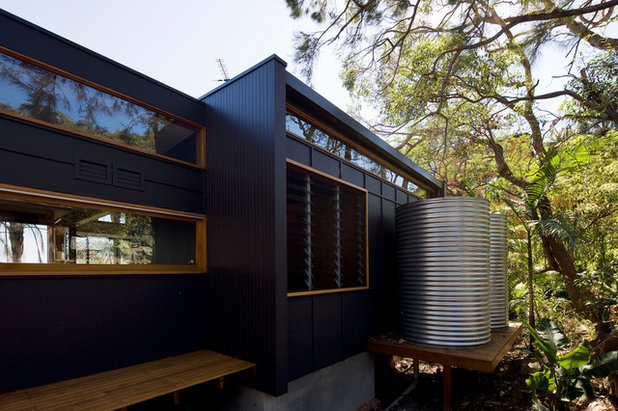
Matt Elkan Architect
Cistern versus rain barrel. There are two types of rainwater catchment systems for homeowners: the cistern and the rain barrel. Cisterns are large tanks that can hold up to 20,000 gallons of water in residential settings, while a standard rain barrel is smaller, usually holding about 55 gallons.
Because of their size, cisterns are more of an undertaking than rain barrels and benefit from professional advice and help with installation. Everyone can install a rain barrel. They take up very little space and are quite affordable. The barrels are always placed above ground, while a cistern can go above or below.
Read more about the benefits of rain barrels
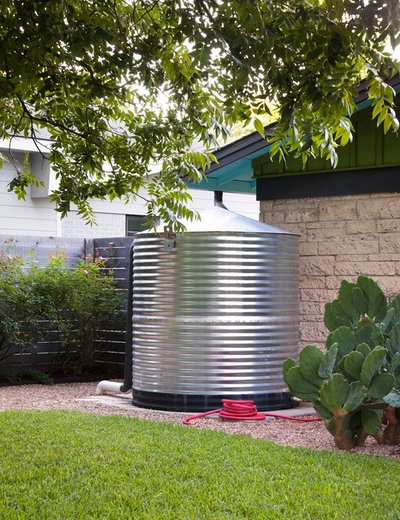
B. Jane Gardens
Why use a cistern? One advantage of choosing a super-sized cistern over a rain barrel is that it lets you store more water, resulting in a greater benefit to watershed health. Cisterns and rain barrels can be used in conjunction with other sustainable stormwater techniques in the landscape, such as rain gardens and swales. When evaluating whether to choose a cistern over a rain barrel, consider the following:
Pros- Cisterns store more water for longer periods
- Potential to add additional cisterns later if space and budget allow
- Potentially eliminate the use of potable water irrigation for your entire landscape
- Can be integrated with greywater reuse systems to reduce your home’s overall water use
- Can be installed underground or above ground
Cons- Require a large amount of space
- Large initial investment
- Require professional installation help because of their size
- Cisterns over 5,000 gallons in capacity also need structural support at their base
- Prohibited in Colorado; instead you can redirect roof rainwater to a rain garden for infiltration
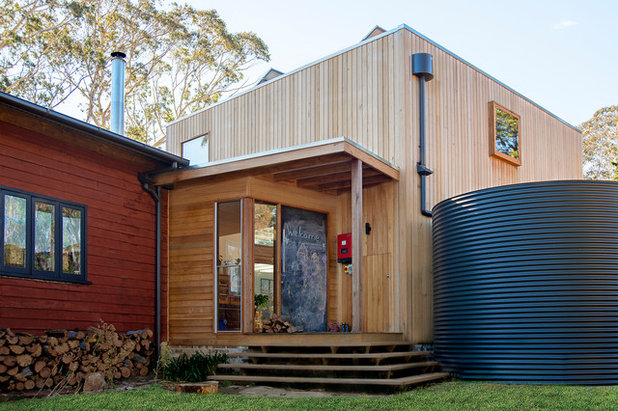
six b design
How much does it cost? On the low end, an 800-gallon cistern can cost anywhere from $500 to $1,000, depending on the material you choose. On the high end, an extra-large cistern with a 20,000-gallon capacity and structural concrete foundation can cost up to $20,000, not including the labor to install it.
Large-scale, high-end cisterns are usually used for offsetting the amount of potable water used inside the home and for the landscape and need to be designed in consultation with an architect and engineer.
An underground cistern requires excavation, which also adds to the cost. Underground cisterns are designed on a case-by-case basis and in consultation with an engineer and landscape architect.
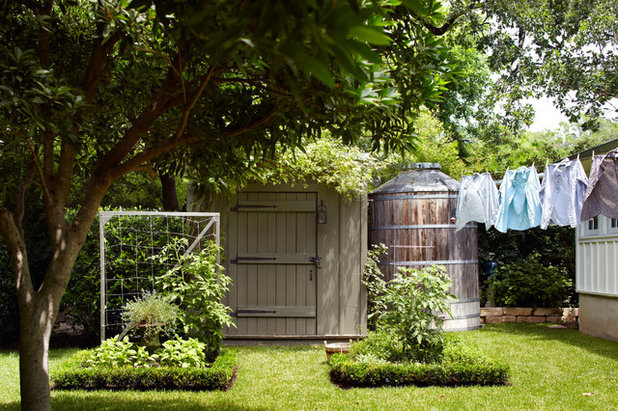
Tim Cuppett Architects
Sizing your cistern. The size of your cistern depends on how much rainwater you want to harvest, how much space you have and how much money you want to invest.
Sizing a cistern can be done with a rainwater harvesting tool, like this one from Texas A&M University. Have someone double-check your calculations, and talk with the company selling you the cistern; it will likely confirm the calculations for you.
You can also hire a design professional or green building professional to help you choose the cistern that’s best for you. Among the types of professionals who can help: master plumbers, green builders, LEED-certified professionals, landscape architects and building architects. Look for professionals who specialize in green, sustainable building and design.
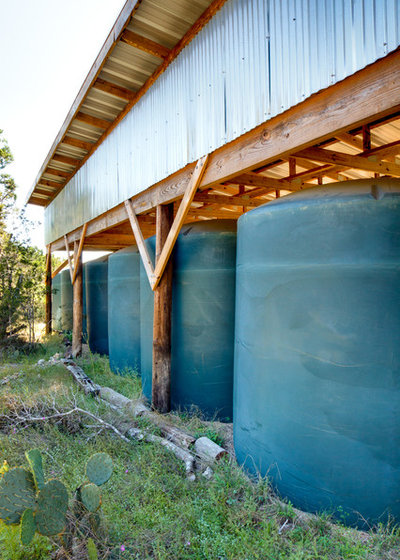
A.GRUPPO Architects - San Marcos
Key components of a cistern. Companies that sell cisterns usually also sell kits that include the system components you need to get fully up and running. Here are the main components of a cistern system:
- Water holding tank (cistern): Collects and stores the rainwater for later use
- Cover or lid: Keeps tank airtight, but can be removed for maintenance
- Leaf and mosquito screen: Placed at the water inlet to keep leaves and bugs out of the tank
- Overflow mechanism: Allows water to overflow through a directed pipe; consider sending your overflow to a rain garden
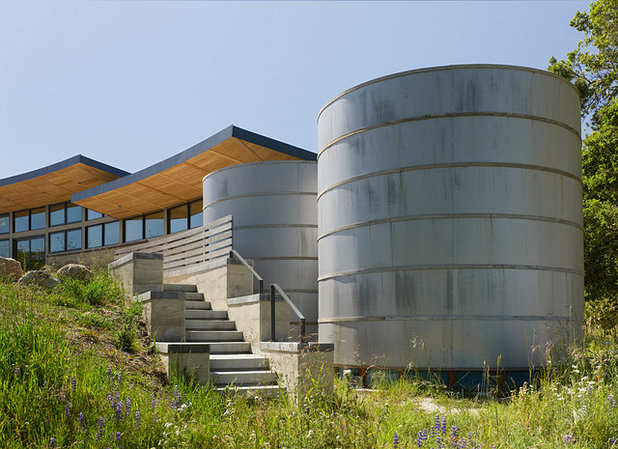
Feldman Architecture, Inc.
Cistern materials. Because cisterns are quite large, they can make a statement in the yard. You could tuck a smaller cistern behind a wall or lush hedge. For an extra-large cistern, however, you’ll want to coordinate the material with your home’s landscape and architecture. It’s not that the cistern needs to match the home, but it should be chosen and placed in a way that complements the house and landscape. All cisterns should be completely opaque to prohibit algae growth.
Popular materials for cisterns include:
- Concrete: Can be pre-cast or cast in place; a major advantage is that concrete reduces the water’s acidity over time
- Metal: Strong and lightweight; needs to be galvanized and contain a plastic liner
- Polyethylene: Most affordable and most readily available cistern material; not particularly attractive
- Plastic: Affordable but has only a 25-year life span in most cases
- Wood (with a plastic liner): More aesthetically pleasing but also more expensive and not as readily available
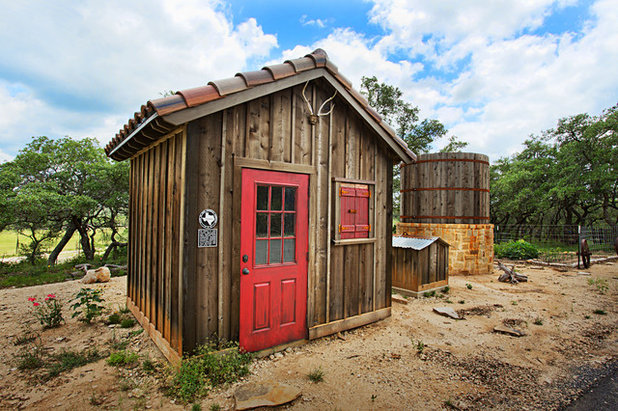
Jim Boles Custom Homes
The wood barrel-style cistern shown here has coordinated materials and colors. Notice how the red metal bands on the cistern play nicely with the red shed door and mini-shutters.
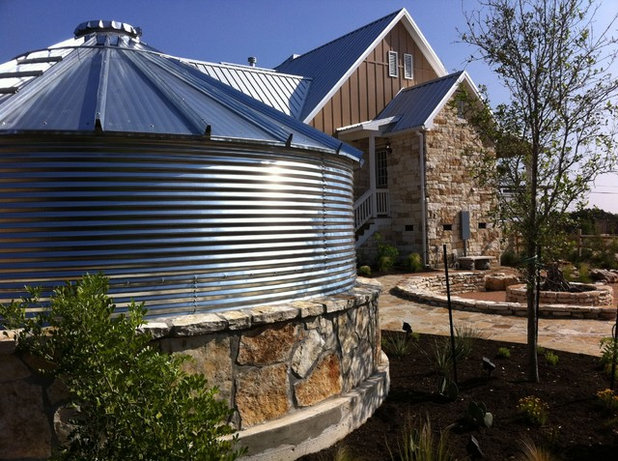
Innovative Water Solutions LLC
Rainwater Harvesting Systems
This home has a metal roof with a natural stone facade, and the extra-large cistern is designed to have a similar style with a corrugated metal top and natural stone facade on the low wall surround.
 Where to place your cistern.
Where to place your cistern. Placement should be done in consultation with your architect or in consultation with your landscape architect if the cistern is for storing roof runoff. Some general guidelines are as follows:
- Check with your local building code on setbacks and regulations. A cistern will probably be treated as a “landscape structure” and may require a permit.
- The most cost-effective location will be closest to the source point for the water to be stored — for example, next to a downspout that collects roof runoff.
- It’s easiest to place the cistern uphill from where the water will be used. This eliminates the need for pumping the water, allowing gravity to do the work for you.
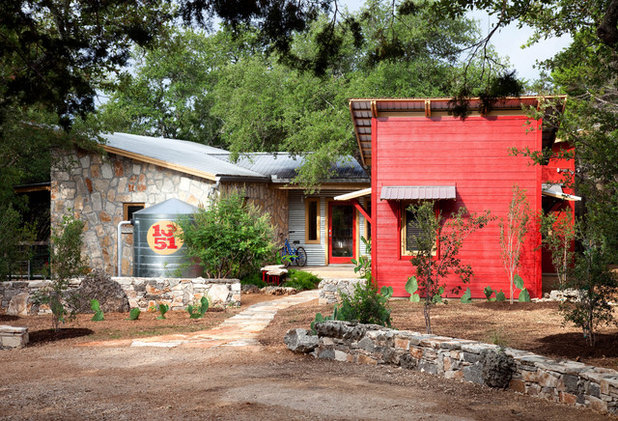
B. Jane Gardens
Uses for collected water. Collected roof runoff is best used on nonedible landscape plants. You can use the water to irrigate your lawn, trees, flower beds and more.
Show us: Have you incorporated a cistern into your landscape? Upload pictures in the Comments.





